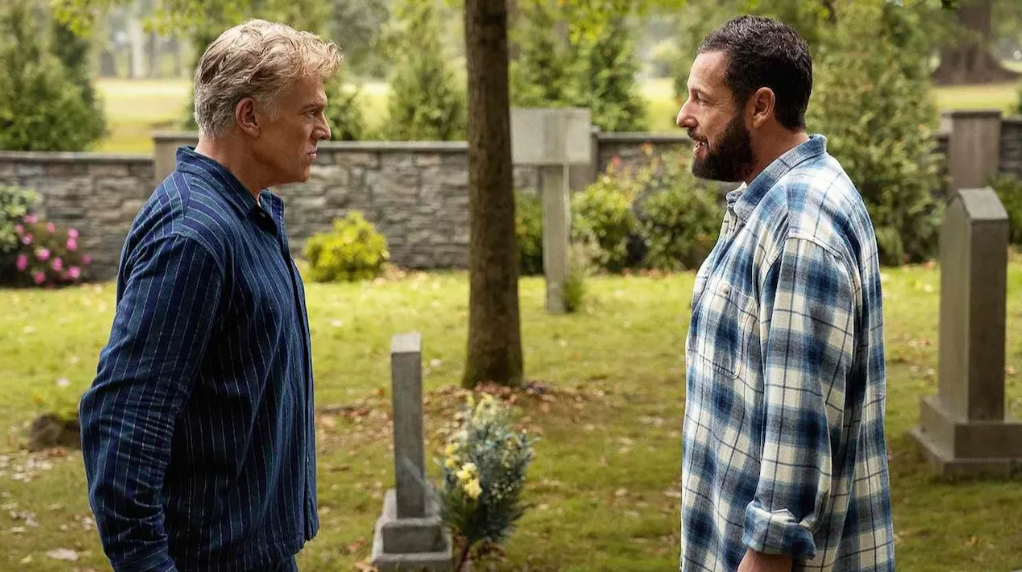Physical Address
304 North Cardinal St.
Dorchester Center, MA 02124
Physical Address
304 North Cardinal St.
Dorchester Center, MA 02124

Nearly thirty years after the original sports comedy became a cultural phenomenon, Happy Gilmore 2 opens with Adam Sandler’s fiery character bringing viewers up to speed on everything that’s transpired since.
After his triumphant defeat of nemesis Shooter McGavin and a fairy-tale ending with Virginia, Happy Gilmore settles into a prosperous life, raising five children and enjoying increasing wealth. Although he contemplates retirement, Virginia encourages him to keep playing. However, tragedy strikes in the film’s opening moments when Happy accidentally kills her with a misfired tee shot—a shock that turns his world upside down, more profoundly than his orphaned childhood ever did.
Unlike before, Happy doesn’t have to abandon his first love, hockey, to raise money for grandma’s house. Instead, he abruptly leaves golf to focus on fatherhood, believing his financial worries are behind him—until the authorities seize both the house and his flashy Ferrari. With his four sons mostly grown, he moves into a rundown apartment in a rough neighborhood with his youngest daughter, Vienna (played by Sunny Sandler), and sinks into alcoholism.
Hope returns when Vienna’s ballet instructor (played by Jackie Sandler) recognizes her talent, offering a chance to study at a prestigious Paris academy. Motivated to support her dreams, Happy picks up his golf clubs once more to raise tuition money. Yet his comeback is complicated by a DUI incident and an enticing offer from a dubious energy drink entrepreneur who invites him to join a rebel golf league aiming to disrupt the traditional tour—sound familiar?
As with many sequels, Happy Gilmore 2 doesn’t quite recapture the charm of the original—a film that earned a spot alongside classics like Caddyshack. However, devoted fans will likely be unfazed. For those who have spent years quoting lines such as “must be Burt Reynolds” at passing limousines, the nostalgia is strong. Sandler and co-writer Tim Herlihy sprinkle in plenty of familiar humor, including clever running jokes (like Happy turning everyday objects—club brushes, remote controls—into flasks) and cameos from Sandler’s regular collaborators such as Kevin Nealon, Jon Lovitz, Rob Schneider, and Steve Buscemi. The film also pays touching homage to cast members lost over the years—most notably Carl Weathers, whose character Chubbs is honored during a cemetery showdown between Happy and McGavin, echoing Bob Barker’s iconic cameo in the original.
Where the first Happy Gilmore told the story of an outsider shaking up the golf world, the sequel reverses this: Happy is now among the elite. Recognized as a legend on par with Tiger Woods, he shares the screen with modern stars like Jordan Spieth and Xander Schauffele, as well as legends including Jack Nicklaus and Fred Couples. Lee Trevino—the only pro golfer to appear in the 1996 film—returns, while John Daly, whose tumultuous career seems to have inspired parts of Happy’s story, makes a memorable appearance living in Happy’s garage. The film humorously references real golf events, with Scottie Scheffler poking fun at his 2024 PGA arrest, and Will Zalatoris playing up his uncanny resemblance to Happy’s first caddie. If the original was a rambunctious love letter to golf, the sequel shows how the sport has fully embraced the joke and the affection behind it.
The movie’s greatest strength lies in its celebration of golf and its traditions. While supporting his daughter’s ballet ambitions, Happy wrestles with the reality that long drives have become commonplace. Scenes featuring amateur players and golf simulators emphasize the franchise’s role in making the sport more approachable. Though the film is weighed down by an overload of celebrity cameos, blatant Sandler family nepotism, and a chaotic final act, these issues are somewhat softened by Bad Bunny’s standout and hilariously charming performance as Happy’s caddie.
Happy Gilmore 2 may sail over the heads of those unfamiliar with golf or the early 2000s Saturday Night Live, but for devoted fans, it serves as a nostalgic reunion, bringing back beloved characters and classic rivalries. The film embraces its old-school charm, appealing mainly to those who appreciate its lighter, simpler style.